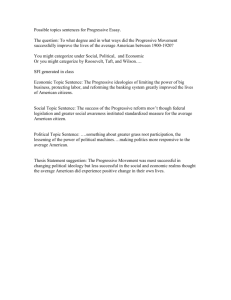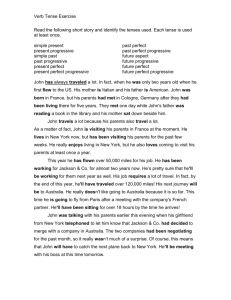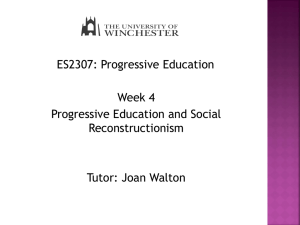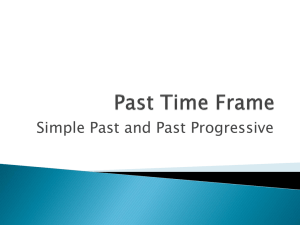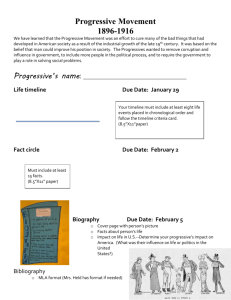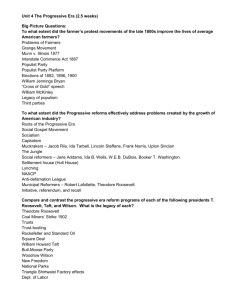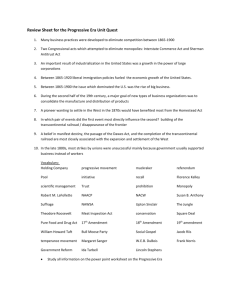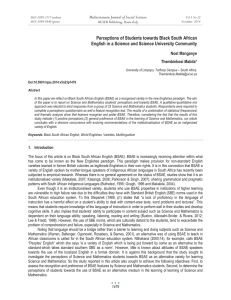Error, Innovation and New Conventions in African Englishes
advertisement
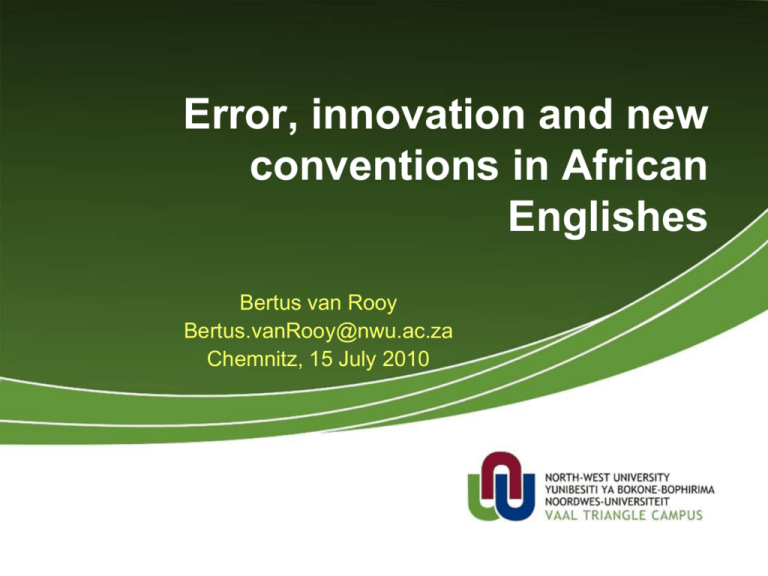
Error, innovation and new conventions in African Englishes Bertus van Rooy Bertus.vanRooy@nwu.ac.za Chemnitz, 15 July 2010 Outline • • • • • • Conceptual issues Problems of interpretation Case study 1: progressive Case study 2: can be able to Case study 3: enable + V(inf) Early and confusing indications from eye-tracking data • Conclusions Conceptual issues • Two camps (at least, although not homogenous): – Learners all of them / Applied Linguistics / SLA – World Englishes / Sociolinguistics of New Varieties Conceptual issues • The challenge for Camp 2: Titlestad (1996:168): The random errors of second-language learners at various stages of acquisition do not make a new English unless a codifiable consistency can be demonstrated. De Klerk (1999:315): When does a substratal feature assert itself sufficiently to overcome the fear that if deviations are allowed, the rules will be abandoned and chaos will ensue? Is it when speakers use it often enough to silence or exhaust the prescriptors? Perhaps benign neglect is what is called for, rather than intervention, and time is the ultimate strategy towards legitimation (Gonzales, 1997: 210), although ultimately the test is the speakers' ability to deliver their message among themselves and to the outside world. Problems of interpretation • • • • Innovation vs. Error Deficiency, deviation, difference Different mental representations? Different probabilities? Problems of interpretation • • • • • Innovation vs. diffusion Psychological versus social Systemic versus atomic Identity and accommodation Difference in Probability and/or frequency? Problems of interpretation • Sources of innovation: – – – – Error Transfer Creativity Analogy • Conventionalisation? – Some innovations are once-off – Some innovations have limited shelf-life („like slang‟) – Some innovations become new conventions Problems of interpretation • Criteria for conventionalisation: – Systematic • Variation should be non-random, should correlate with more than just language proficiency level – Acceptable • Feature should be judged acceptable, and-or used widely, especially beyond the innovating community Case study 1: progressive • Previous research: extended use / misrecognition of stative/dynamic contrast • Implications: poor acquisition, no system and motivation behind variation in form (progressive vs. unmarked) Case study 1: progressive • Prototype BrE: • They found something on everybody, including the witnesses, the prosecution and defense lawyers, and even the dismissed jurors. How did they know what the jurors were doing and where they were sitting in the restaurants? (LOCNESS – USSCU0012-4) • Prototype BSAE: • most of the teenagers and Adults are suffering from this disease (TLE) • We are living in the present contex[t]ual situation (TLE) Case study 1: progressive • Systematicity: • Van Rooy (2006, 2008) – new prototype (persistitive), aspectual contrasts more important in BSAE than tense • Acceptability: • Gough (1996) – rejection by all respondents (20 teachers) • Van der Walt & Van Rooy (2002) – 96% acceptance among 60 teachers, 67% acceptance among 670 students Case study 2: can be able to • Previous research (Gough 1996, Mesthrie 2004): tautology of „can‟ (meaning ability) and „be able to‟ • De Klerk (2003:476) „can‟ used in permission sense, leaving „be able to‟ for ability, implied suggestion (?) that „can‟ mainly used to express permission (and perhaps possibility) • Implications: if anything, a reduced system, combined with overly explicit marking of meanings (following Williams 1987…) Case study 2: can be able to • Coaches put more effort in their players so that they can be able to win. • People become sick for a long time and this caused Aids because this diseas[e] will kill all your im[m]une system and the body can‟t be able to [defend] itself against other diseases. Case study 2: can be able to • And we also have a project on Cuba, Rwanda and South Africa and Cuban doctors, and we have agreed to fund part of that project from the Renaissance programme and we agreed that we should get an MOU signed so that we can be able to continue with that project. (Minister of Foreign Affairs) • 16. How many times will the telephone ring before it routes to the mailbox, when it remains unanswered? The telephone will ring seven times ( 20 seconds) before routing to the mailbox. Enhancement features have been developed, whereby customers can be able to program the ringing time according to their needs (See the ringing times under Enhanced Features). (TELKOM website) Case study 2: can be able to • Systematicity: • Also attested widely in other Englishes, including Early Modern BrE • Van Rooy (2005) – “can”= POSSIBILITY, combined with analytic expression of ABILITY • Acceptability: • Gough (1996) – rejection by 13/20 respondents • Now: extensive use on internet, including edited, formal documents Case study 3: enable + bare-inf • Complementation patterns much attention in current research • Buregeya (2006) enable + bare-inf occurs alongside enable + to-inf complement clause • No semantics yet done on this construction, but generally (Mair 1995, Egan 2008): – Bare-inf suggests greater degree of involvement of Causer in causative construction – To-inf lesser degree of involvement, causation more indirect Case study 3: enable + bare inf 1. All that money enabled me start this business of shop (ICE-EA, S2B-073K) 2. support to the people in the form of advice materials loans and designing to enable them build better and permanent (ICE-EA, S2B-027T) 3. The project is however at its early stages and is awaiting funds to enable it operate efficiently. (ICEEA, W2B-030K) 4. The meeting had been called to "review points" which would enable the directors issue title deeds as soon as possible. (ICE-EA, W2C-026K) Case study 3: enable + bare inf 100 Complementation pattern (%) 90 80 70 60 50 40 30 20 10 0 require cause allow force Bare-inf enable To-inf help let Case study 3: enable + bare inf • Systematicity: • Syntactic distribution like „help‟, an attested possibility, and unlike once-off errors • Semantics yet to be confirmed • Acceptability: • Buregeya (2006:216) accepted by 79% of 160 student respondents Eye-tracking data • Very provisional analysis of BSAE data • 10 speakers in test group, 10 in control group • Measurements: – – – – Total fixations Regressions First fixation duration Total gaze time Eye-tracking data • Almost no effect: (non-std) zero articles • Limited effect: clear formal (morphological) errors • Clearer effect: cohesion errors, but only if sense is affected • Red sirens: shibboleth features of BSAE – – – – Progressive: “is having AIDS” „can be able to‟ Resumptive pronoun Complementation „make Obj to cause‟ Eye-tracking data: BSAE vs error • Can be able to; Progressive • Participle error, concord plural • Longer fixations on target words, • more fixations, • only few regressions on CBAT, not on having • Almost no difference Eye-tracking data: BSAE vs error • Complementation of causative verb • More regressions • Longer reading duration • Preposition errors: extra prep or different prep • Almost no difference Eye-tracking data: BSAE vs error • Resumptive • More regressions in context, refixations on the resumptive pronoun • Longer reading time • Pronoun case, Dem number • More regressions, fixations, but no difference in duration Eye-tracking data: BSAE vs error • BSAE innovations • Errors • Draw attention, are attended to • Processing to be expected for their syntax • Generally skipped over, not attended to • – some limited effects are observed for most, but not on the same scale • Unless they affect understanding (esp. Cohesion) Conclusions? • Errors are errors, if that means deviation from some set of expectations, but is this interesting? – Errors are more clearly errors if that means not saying what you intended (=mistakes for EA/IL) • Errors form one possible source of innovation among others – Assigning blame is interesting, but is it worth-while? • Some errors show systematic variation of the sociolinguistic and even the semantic kind, not mere correlations with degree of proficiency • But, they keep swimming upstream against prescriptions (perhaps for generations) before gaining acceptance, hence the red lights, perhaps THANK YOU

